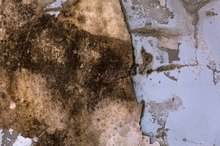Allergies to Memory Foam
Memory foam is a type of material that conforms to the shape of a person’s body and that is used to make various bedding materials, including mattresses, mattress toppers and pillows. Many people buy memory foam for the comfort benefits 1. Unfortunately, their efforts to feel better can backfire, as it is not uncommon for people to experience allergic symptoms when they are exposed to memory foam.
Significance
Because a person spends more time in the bedroom, and in particular on the bed, than anywhere else, it is crucial that the bed be healthy and nontoxic. When a person is on a bed, he is very close to any potentially allergenic materials and thus much more likely to react to any harmful substances.
History
Allergies to Bedding
Learn More
Memory foam-type material was first developed in the early 1970s in a quest for comfortable material for astronauts during liftoff, according to Memory Foam Mattress, and the commercial foam product was introduced in the 1990s. Memory foam bedding material became popular because of the benefits people found, including relief from painful pressure points and less back pain.
Materials
According to Dr. Cara Natterson, memory foam consists of many chemicals that have not been tested on humans. Although there is not a great deal of research on the topic, memory foam likely contains materials that emit toxic chemicals and gases, according to Natterson. Pesticides and formaldehyde are some of the harmful materials. Also, especially when they are new, memory foam materials can offgas, which creates strong fumes that can cause allergic symptoms.
- According to Dr. Cara Natterson, memory foam consists of many chemicals that have not been tested on humans.
- Although there is not a great deal of research on the topic, memory foam likely contains materials that emit toxic chemicals and gases, according to Natterson.
Symptoms
Unhealthy Effects of Tempurpedic Mattresses
Learn More
Many people decide to get memory foam mattresses to get away from allergies—standard coiled mattresses can harbor dust, for example, which can trigger allergic symptoms. However, they might experience just as many allergic symptoms when making the switch to memory foam.
Solutions
An obvious way to avoid memory foam allergies is to use a mattress made of different material. For example, standard coiled mattresses are an option, although these can still contain materials such as chemicals and foams that trigger allergic symptoms. Hypoallergenic bedding materials do exist, such as organic and toxin-free ones, and it is important to investigate your options. Adding a cover around the mattress that provides a barrier and prevents you from breathing allergy-inducing fumes from the mattress is another possible solution.
- An obvious way to avoid memory foam allergies is to use a mattress made of different material.
- For example, standard coiled mattresses are an option, although these can still contain materials such as chemicals and foams that trigger allergic symptoms.
Related Articles
References
Resources
Writer Bio
Judy Wilson has writing and editing expertise in health, technology, pets, business and travel. She has contributed to USAToday.com, SFGate.com and numerous other publications. Wilson earned a Bachelor of Arts in journalism and mass communication from the University of North Carolina at Chapel Hill, where she completed Mini Medical School.









